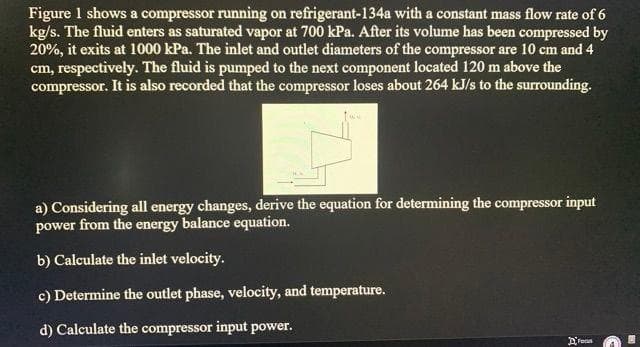Figure 1 shows a compressor running on refrigerant-134a with a constant mass flow rate of 6 kg/s. The fluid enters as saturated vapor at 700 kPa. After its volume has been compressed by 20%, it exits at 1000 kPa. The inlet and outlet diameters of the compressor are 10 cm and 4 cm, respectively. The fluid is pumped to the next component located 120 m above the compressor. It is also recorded that the compressor loses about 264 kJ/s to the surrounding. a) Considering all energy changes, derive the equation for determining the compressor input power from the energy balance equation. b) Calculate the inlet velocity. c) Determine the outlet phase, velocity, and temperature. d) Calculate the compressor input power.
Figure 1 shows a compressor running on refrigerant-134a with a constant mass flow rate of 6 kg/s. The fluid enters as saturated vapor at 700 kPa. After its volume has been compressed by 20%, it exits at 1000 kPa. The inlet and outlet diameters of the compressor are 10 cm and 4 cm, respectively. The fluid is pumped to the next component located 120 m above the compressor. It is also recorded that the compressor loses about 264 kJ/s to the surrounding. a) Considering all energy changes, derive the equation for determining the compressor input power from the energy balance equation. b) Calculate the inlet velocity. c) Determine the outlet phase, velocity, and temperature. d) Calculate the compressor input power.
Elements Of Electromagnetics
7th Edition
ISBN:9780190698614
Author:Sadiku, Matthew N. O.
Publisher:Sadiku, Matthew N. O.
ChapterMA: Math Assessment
Section: Chapter Questions
Problem 1.1MA
Related questions
Question
A5

Transcribed Image Text:Figure 1 shows a compressor running on refrigerant-134a with a constant mass flow rate of 6
kg/s. The fluid enters as saturated vapor at 700 kPa. After its volume has been compressed by
20%, it exits at 1000 kPa. The inlet and outlet diameters of the compressor are 10 cm and 4
cm, respectively. The fluid is pumped to the next component located 120 m above the
compressor. It is also recorded that the compressor loses about 264 kJ/s to the surrounding.
a) Considering all energy changes, derive the equation for determining the compressor input
power from the energy balance equation.
b) Calculate the inlet velocity.
c) Determine the outlet phase, velocity, and temperature.
d) Calculate the compressor input power.
Focus
Expert Solution
This question has been solved!
Explore an expertly crafted, step-by-step solution for a thorough understanding of key concepts.
Step by step
Solved in 4 steps with 4 images

Knowledge Booster
Learn more about
Need a deep-dive on the concept behind this application? Look no further. Learn more about this topic, mechanical-engineering and related others by exploring similar questions and additional content below.Recommended textbooks for you

Elements Of Electromagnetics
Mechanical Engineering
ISBN:
9780190698614
Author:
Sadiku, Matthew N. O.
Publisher:
Oxford University Press

Mechanics of Materials (10th Edition)
Mechanical Engineering
ISBN:
9780134319650
Author:
Russell C. Hibbeler
Publisher:
PEARSON

Thermodynamics: An Engineering Approach
Mechanical Engineering
ISBN:
9781259822674
Author:
Yunus A. Cengel Dr., Michael A. Boles
Publisher:
McGraw-Hill Education

Elements Of Electromagnetics
Mechanical Engineering
ISBN:
9780190698614
Author:
Sadiku, Matthew N. O.
Publisher:
Oxford University Press

Mechanics of Materials (10th Edition)
Mechanical Engineering
ISBN:
9780134319650
Author:
Russell C. Hibbeler
Publisher:
PEARSON

Thermodynamics: An Engineering Approach
Mechanical Engineering
ISBN:
9781259822674
Author:
Yunus A. Cengel Dr., Michael A. Boles
Publisher:
McGraw-Hill Education

Control Systems Engineering
Mechanical Engineering
ISBN:
9781118170519
Author:
Norman S. Nise
Publisher:
WILEY

Mechanics of Materials (MindTap Course List)
Mechanical Engineering
ISBN:
9781337093347
Author:
Barry J. Goodno, James M. Gere
Publisher:
Cengage Learning

Engineering Mechanics: Statics
Mechanical Engineering
ISBN:
9781118807330
Author:
James L. Meriam, L. G. Kraige, J. N. Bolton
Publisher:
WILEY